Étiquette : Danish Radio Orchestra
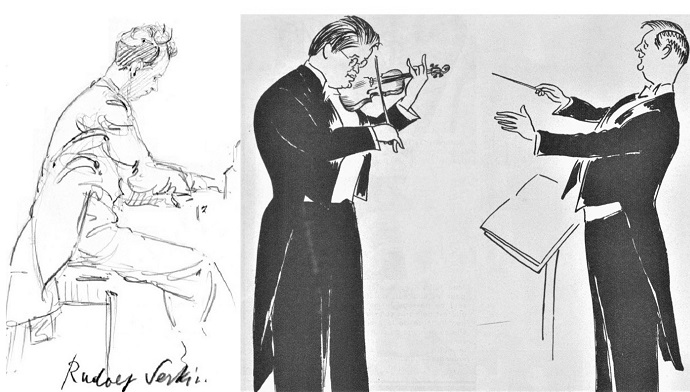
Bach Sonate n°1 BWV 1001: II Fuga – III Siciliana – IV Presto Adolf Busch, Violin – 18 January 1934
____________
Concerto n°2 BWV 1042: III Allegro assai Adolf Busch, Violin – 29 November 1934
Beethoven Concerto n°4 Op58: I Allegro moderato Rudolf Serkin, piano – 23 February 1933
Fritz Busch Radio Symfoniorkestret (Danish Radio Orchestra)
Source: Bande/Tape 38 cm/s / 15 ips
Ces enregistrements de la Radio Danoise montrent trop brièvement Adolf Busch et Rudolf Serkin sous la direction de Fritz Busch, et Adolf Busch en soliste dans une Sonate de Bach dont il manque malheureusement le premier mouvement. Dans le premier mouvement du concerto de Beethoven, Rudolf Serkin et Fritz Busch se montrent ici bien meilleurs que dans l’enregistrement de concert de Serkin avec Toscanini (NBC SO – 26 novembre 1944).
La Radio Danoise disposait de deux platines Neumann et de supports de gravure directe de très grande qualité, d’où un rendu sonore étonnant pour des captations radiophoniques en public du milieu années trente, dont les CD Danacord, beaucoup trop filtrés ne sont qu’un pâle reflet. Le caractère parcellaire des enregistrements conservés provient du fait que la Radio n’avait pas de possibilité contractuelle de réaliser des archives des concerts diffusés en direct. Ces brefs regards sur ces artistes en concert publics n’en sont que plus précieux.
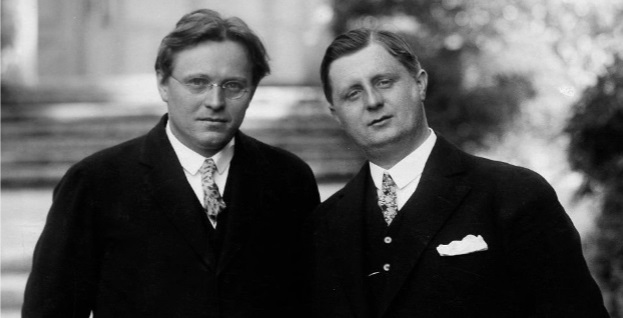
Adolf & Fritz Busch 1931
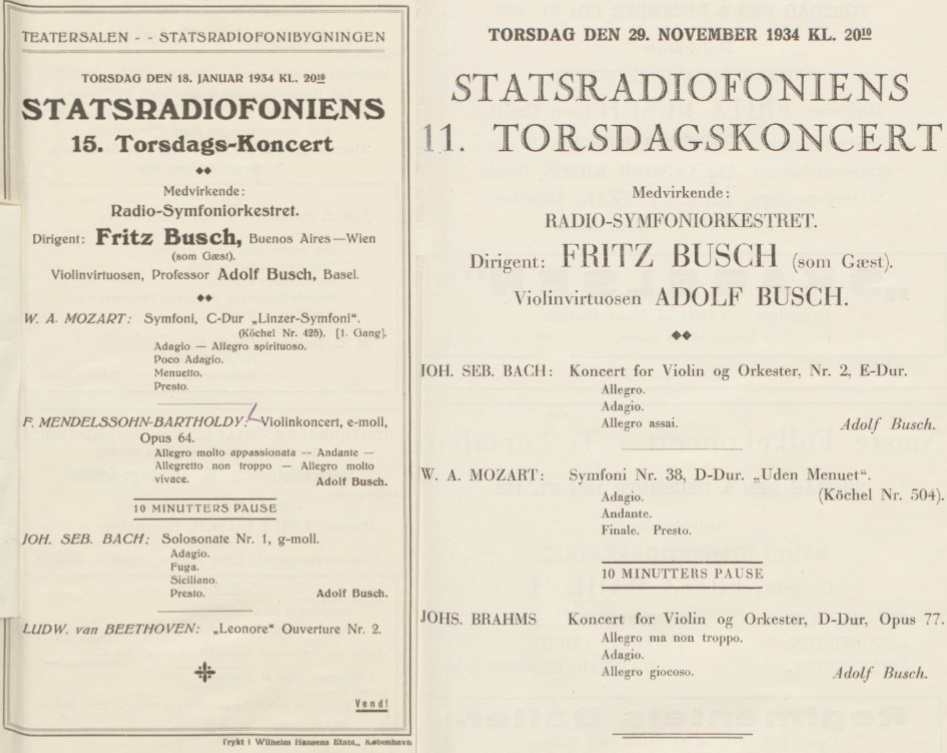
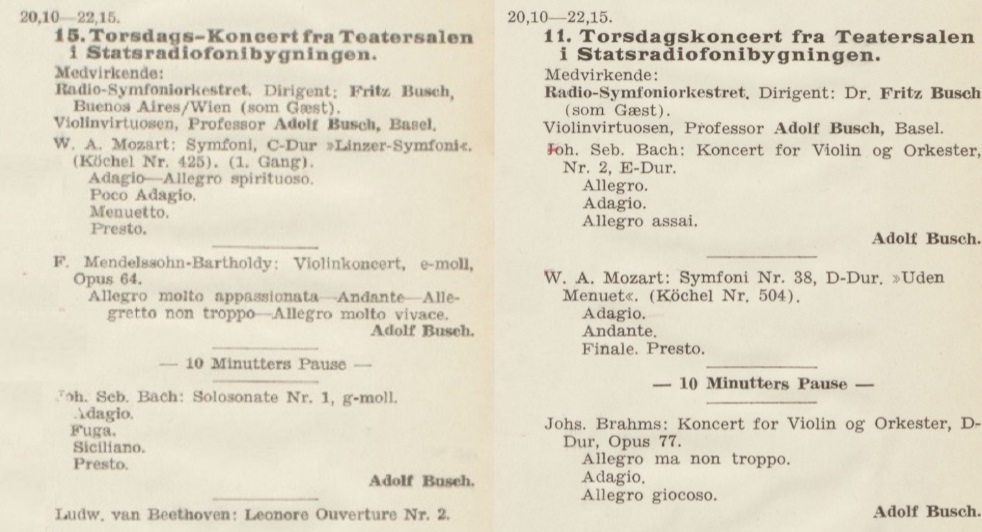

These Danish Radio recordings show Adolf Busch and Rudolf Serkin too briefly under the direction of Fritz Busch, and Adolf Busch as soloist in a Bach Sonata, the first movement of which is unfortunately missing. In the first movement of the Beethoven concerto, Rudolf Serkin and Fritz Busch are much better than in Serkin’s concert recording with Toscanini (NBC SO – 26 November 1944).
The Danish Radio had two Neumann turntables and very high quality direct recording media, resulting in an astonishing sound rendition for broadcast live recordings from the mid-thirties, of which the Danacord CDs, much too filtered, are only a pale reflection. The fragmentary nature of the preserved recordings comes from the fact that the Radio had no contractual possibility of making archives of the concerts broadcast live. These brief glimpses of these artists in public concerts are all the more precious.

Fritz Busch – Radio Symfoniorkestret Statsradiofoniens Kor
Orchestre et Chœurs de la Radio Danoise / Danish Radio Orchestra and Choir
Copenhagen Odd Fellow Palæet
Source: Bandes 38 cm/s / 15 ips Tapes
Haydn Die Schöpfung Hob. XXI:2 – Part II:
Erna Berger, soprano; Julius Patzak, tenor; Alexander Kipnis, Bass – 6 December 1934
n°14 ‘Und Gott sprach’ & n°15 Arie ‘Auf starkem Fittiche’ Erna Berger
n°20 ‘Und Gott sprach’ & n°21 ‘Gleich öffnet sich der Erde Schoss’ Alexander Kipnis
n°23 ‘Und Gott schuf den Menschen’ & n°24 Arie ‘Mit Würd und Hoheit angetan’ Julius Patzak
n°28 Chor ‘Vollendet ist das grosse Werk’*
*inédit/never published before in any format
______________
Beethoven: Erika Rokyta, soprano; Ingeborg Steffensen, mezzo; Koloman von Pataky, tenor; Alexander Kipnis, bass
Missa Solemnis Op.123 Sanctus – 14 February 1935
Symphonie n°9 Op.125- IV Presto – Allegro assai – Presto – 12 April 1934**
** Report, Montage et ‘Mastering’ / Transfer, Editing and Mastering: Charles Eddi
Alexander Kipnis et Fritz Busch se sont produits ensemble à de nombreuses reprises, comme ici à la Radio Danoise, mais aussi au Teatro Colón de Buenos-Aires, notamment Mozart Don Giovanni (Commendatore), Strauss Arabella (Graf Waldner), Rosenkavalier (Ochs), Wagner Fliegende Hollander (Daland), Götterdämmerung (Hagen), Lohengrin (König Heinrich), Parsifal (Gurnemanz), Rheingold (Fasolt), Tannhäuser (Hermann), Tristan (Marke), et Walküre (Hunding), à l’Opéra de Montevideo pour Wagner Walküre (Hunding), et brièvement au MET pour deux opéras de Wagner, Tristan und Isolde (Marke) et enfin Tannhäuser (Hermann) pour la dernière représentation en public d’un opéra par Kipnis le 6 mai 1946.
Au milieu des années trente, Kipnis était à son sommet, et ces enregistrements le montrent, dont le couronnement est sa participation véritablement historique à la Neuvième Symphonie de Beethoven, où il est bien meilleur qu’avec Toscanini (Teatro Colón 24 juillet 1941 – Music & Arts CD-1119).
Dans le Finale de la ‘Neuvième’, Busch prend un maximum de risques, en n’hésitant pas à pousser l’orchestre et les chœurs au-delà de leurs limites, ce qui par moment mène l’exécution au bord de la rupture. On n’est pas habitué à une telle tension de la part de ce chef, dont la réputation est plutôt celle d’un classique. Sur ce plan, cet enregistrement est vraiment un témoignage unique.
On notera que l’enregistrement du Chœur n°28 qui termine la deuxième partie de la Création (Die Schöpfung) de Haydn est un inédit.
Nous pouvons également à cette occasion entendre d’autres chanteurs célèbres, à savoir Erna Berger, Julius Patzak et Koloman von Pataky.


Odd Fellow Palæet
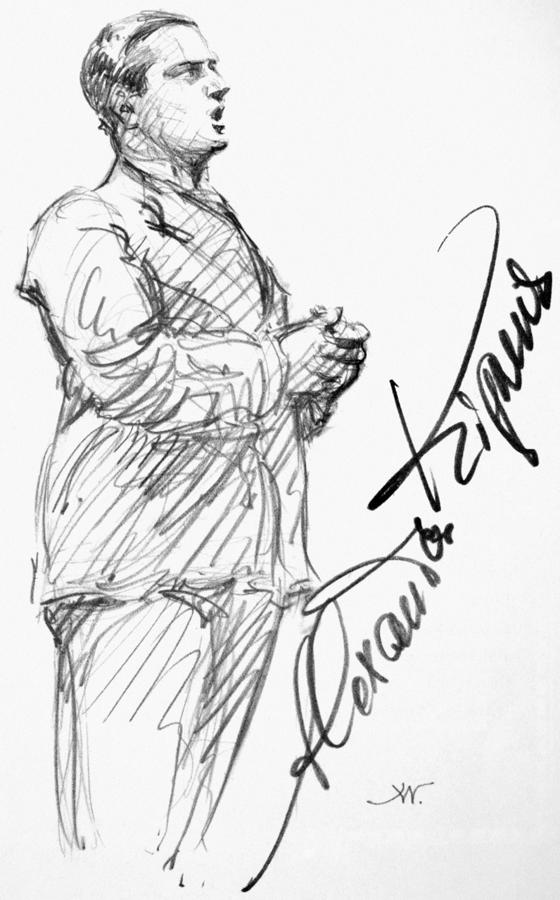

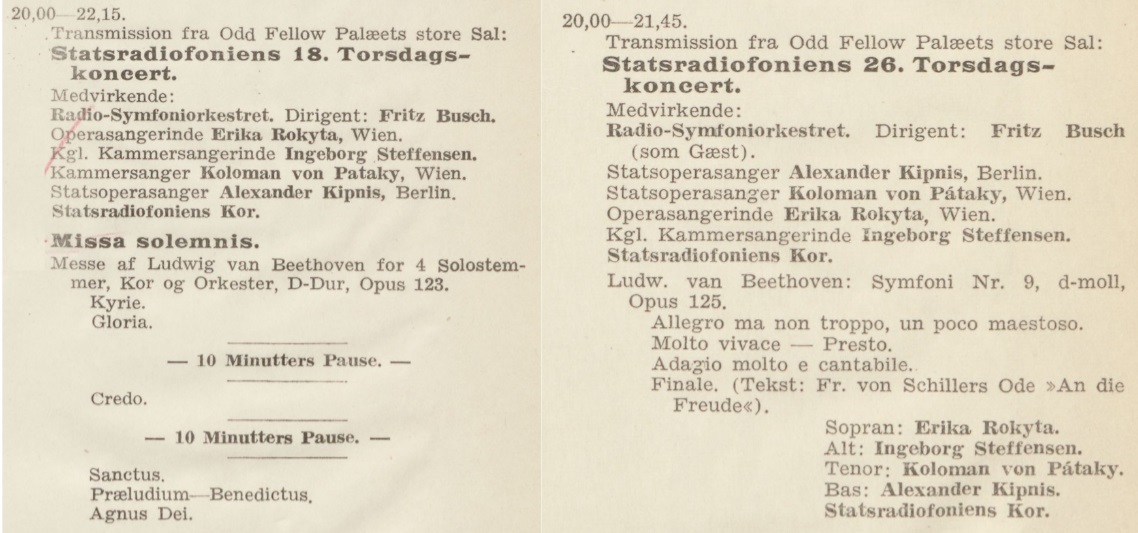
Alexander Kipnis and Fritz Busch have performed together on numerous occasions, such as here at the Danish Radio, but also at the Teatro Colón in Buenos Aires, notably Mozart Don Giovanni (Commendatore), Strauss Arabella (Graf Waldner), Rosenkavalier (Ochs), Wagner Fliegende Hollander (Daland), Götterdämmerung (Hagen), Lohengrin (König Heinrich), Parsifal (Gurnemanz), Rheingold (Fasolt), Tannhäuser (Hermann), Tristan (Marke), and Walküre (Hunding), at the Montevideo Opera for Wagner Walküre (Hunding), and briefly at the MET for two Wagner operas, Tristan und Isolde (Marke) and finally Tannhäuser (Hermann) for Kipnis’ last public performance of an opera on May 6, 1946.
By the mid-1930s, Kipnis was at his peak, and these recordings show it, the crowning of which being this truly his historical performance in Beethoven’s Ninth Symphony, where he is very much better than with Toscanini (Teatro Colón July 24, 1941 – Music & Arts CD-1119).
In the Finale of the ‘Ninth’, Busch takes a maximum of risks, not hesitating to push the orchestra and the chorus beyond their limits, which at times brings the performance to the brink of breakdown. We are not used to such tension from this conductor, whose reputation is rather that of a classic. In this respect, this recording is truly a unique testimony.
It should be noted that the recording of Chorus n°28, which ends the second part of Haydn’s Creation (Die Schöpfung), was never published before.
We can also enjoy hearing other famous singers, namely Erna Berger, Julius Patzak and Koloman von Pataky.

Kathleen Ferrier
Brahms Alt-Rhapsodie Op.53: Chœur d’Hommes et Orchestre de la Radio Danoise (Symfoniorkestret /Statsradiofoniens Mandskor: Svend S. Schultz)
dir: Fritz Busch
2 Lieder: Von ewiger Liebe Op43-I – Wir wandelten Op96-II Phyllis Spurr, piano
Radio Studio n°1 – 6 octobre 1949 Source: 33t/LP Danacord DACO 114
___________
Mahler Kindertotenlieder: WPO Bruno Walter
Kingsway Hall 4 octobre 1949
Prod: Walter Legge/Leonard Smith – Eng: Douglas Larter
Source 33t/LP: Angel Japan EAC-57048
En l’espace de deux jours, Kathleen Ferrier nous a offert deux enregistrements majeurs.
Tout d’abord à Londres où le Philharmonique de Vienne (WPO) était présent du 28 septembre au 6 octobre 1949 au cours d’une tournée dirigée par Furtwängler qui rejoindra ensuite Paris, Genève et Zürich.
Ferrier et Walter, de retour d’Edimbourg, ont donné à Londres les 1 et 2 octobre deux concerts Mahler avec les Kindertotenlieder et la Deuxième Symphonie (BBC SO and Choral Society).
Le 4, Furtwängler a dirigé avec le WPO un concert Brahms avec Menuhin, et une séance d’enregistrement a pu être programmée l’après-midi (14h30-17h30) au Kingsway Hall pour capter les Kindertotenlieder avec Bruno Walter.
Walter dirigea un concert londonien avec le WPO le 6. Mais, ce fut sans Ferrier qui chantait ce jour-là la ‘Alt-Rhapsodie’ avec Fritz Busch à Copenhague. De toutes façons, avec le WPO à Londres, elle n’aurait pas pu chanter l’œuvre de Brahms : Furtwängler avait déjà mis la ‘Alt-Rhapsodie’ au programme de son concert du 28 septembre (avec Mary Jarred).
Le programme dirigé par Fritz Busch avec son Orchestre de la Radio Danoise comprenait la Symphonie n°7 Op.70 de Dvorak (à l’époque dénommée ‘n°2’ comme lors de sa publication), et en deuxième partie, un ou plusieurs airs de l’ ‘Orphée’ de Gluck, puis la Rhapsodie Op.53 de Brahms et enfin les Métamorphoses d’Hindemith:
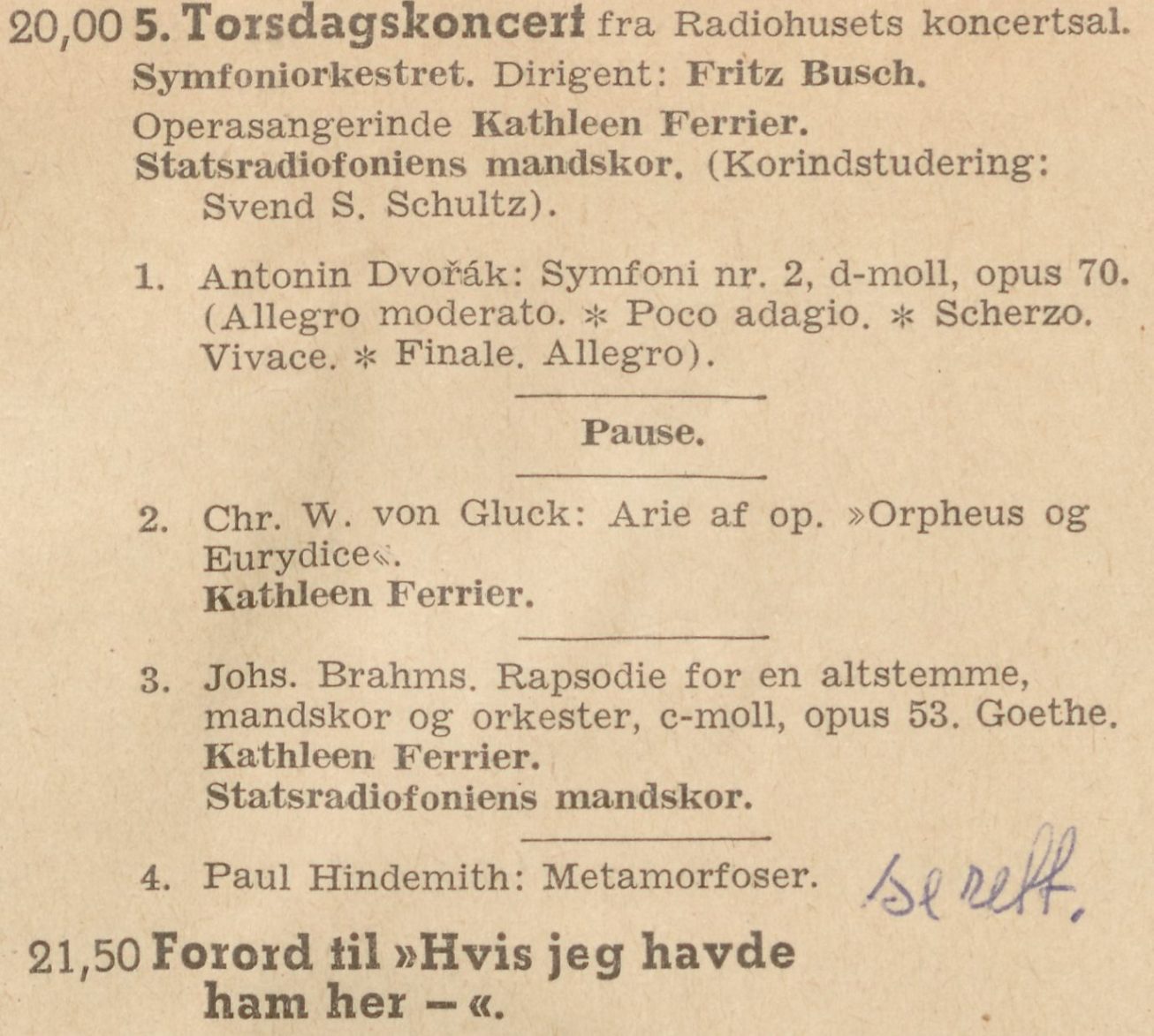
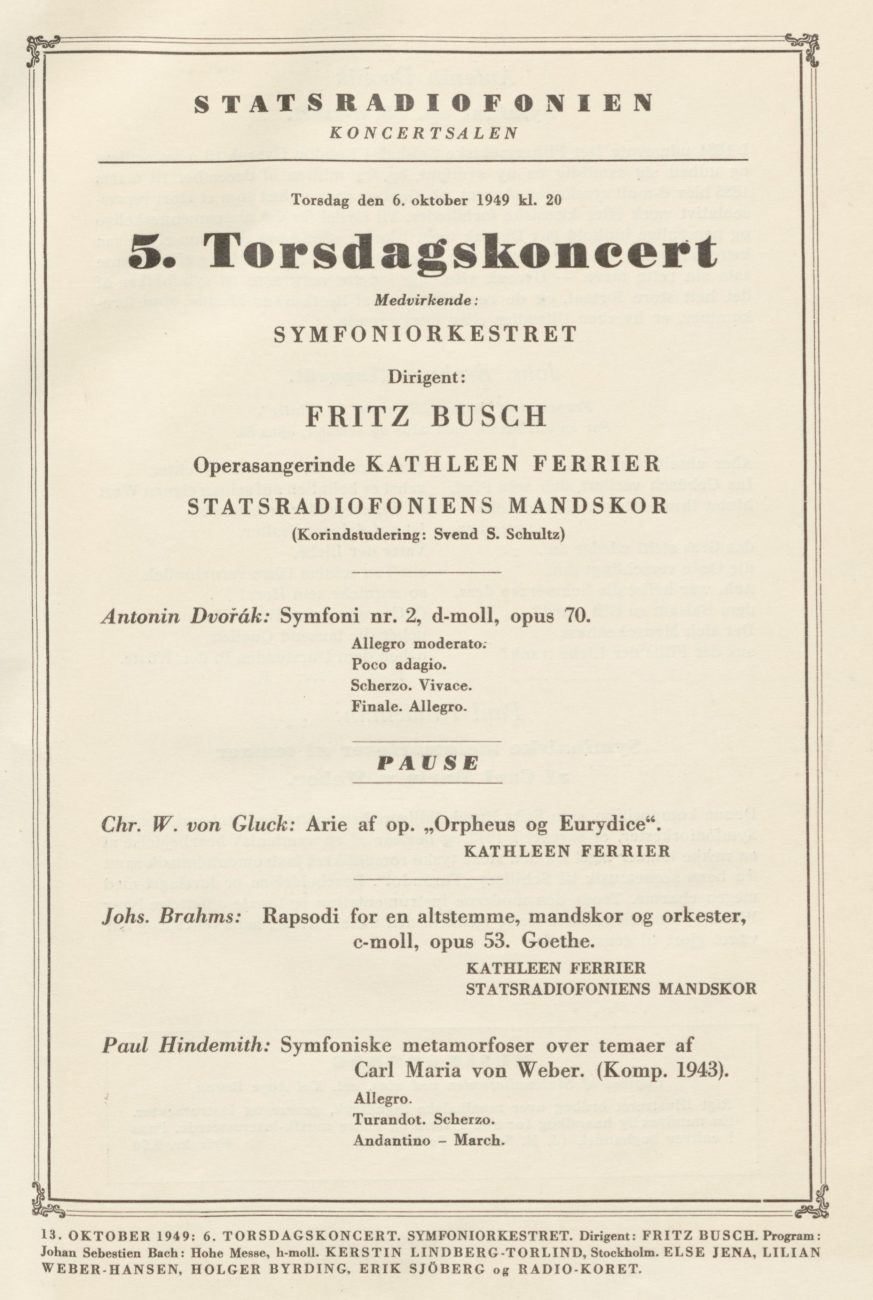
On voit que les deux Lieder de Brahms, probablement joués en bis, dans lesquels Ferrier est accompagnée par sa pianiste venue spécialement pour sa tournée en Scandinavie, ne figurent pas dans ce programme officiel. On les trouve par contre avec Gluck dans une feuille annexe de la Radio:

L’enregistrement de la Rhapsodie Op.53 a été complété par des sources provenant d’enregistrements privés de l’émission de la Radio Danoise pour compenser les parties dégradées de l’archive officielle. Les deux Lieder sont incomplets. Il manque les six premiers vers du premier Lied, et le début de l’introduction pianistique de l’autre.
Kathleen Ferrier et Fritz Busch se sont retrouvés avec l’Orchestre de la Radio Danoise au Festival d’Edimbourg, le 28 août 1950, avec le Royal Choral Union d’Edimbourg pour cette Rhapsodie Op.53.
Fritz Busch avait prévu de faire son grand retour à Berlin en mars 1952. A cette occasion, il avait invité Kathleen Ferrier à ses concerts qui devaient avoir lieu avec les 16 et 17 mars avec l’Orchestre de la RIAS. Sa disparition en septembre 1951 a réduit ce projet à néant.
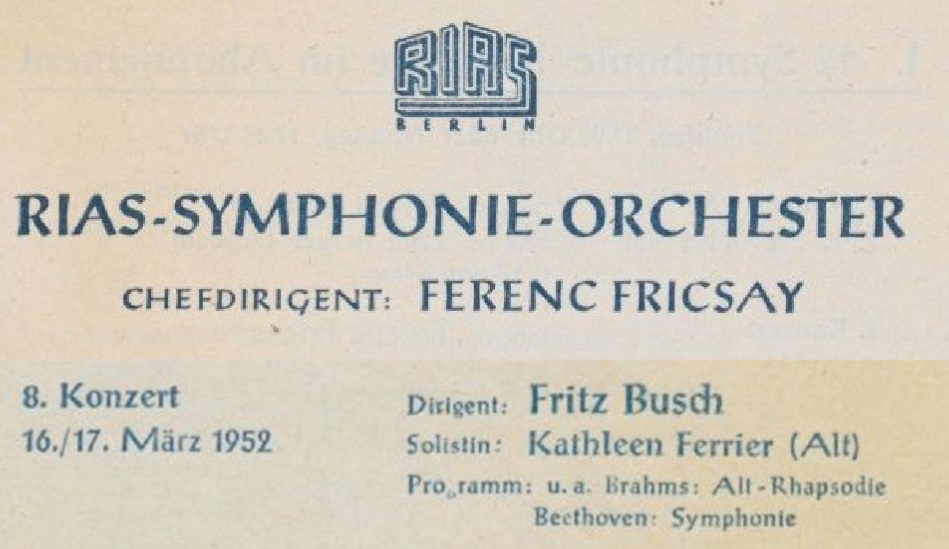
____________

____________
Within two days, Kathleen Ferrier offered us two major recordings.
To start with, in London where the Vienna Philharmonic (WPO) was present between 28 September to 6 October during a tour conducted by Furtwängler which later joined Paris, Geneva and Zürich.
Ferrier and Walter, back from d’Edinburgh, gave on October 1 and 2 two Mahler concerts in London with the Kindertotenlieder and the Second Symphony (BBC SO and Choral Society).
On the 4th, Furtwängler conducted a Brahms concert with Menuhin and the WPO, and an afternoon recording session (2.30pm – 5.30pm) has been set at Kingsway Hall to record the Kindertotenlieder with Bruno Walter.
Walter took the opportunity of being in London to conduct one concert with the WPO on the 6th. But it was without Ferrier who, on that very day, sang the ‘Alt-Rhapsodie’ with Fritz Busch in Copenhagen. Anyway, with the WPO in London, she might not have sung the work by Brahms : Furtwängler already put the ‘Alt-Rhapsodie’ at the program of his concert on 28 September (with Mary Jarred).
The programme conducted by Fritz Busch and his Orchestra of the Danish Radio was comprised of Dvorak’s Symphony n°7 Op.70 (then named ‘n°2’ as when it was published), and for the second part, Arias from Gluck’s Orpheus, then the Rhapsodie Op.53 by Brahms and to end with, Hindemith’s Metamorphosen:

We see that the two Brahms’Lieder, probably performed as encores, in which Ferrier is accompanied by her pianist who came especially for her Scandinavian tour, are not mentioned in this official programme. They are however found with the Gluck item in an extra Radio programme sheet:

The recording of the Rhapsody Op.53 was completed by private sources coming from the broadcast of the Danish Radio Danoise to compensate for the unusable parts of the official archive. Both Lieder are incomplete. The six first verses of the first Lied are missing, as well as the beginning of the piano introduction of the second.
Kathleen Ferrier and Fritz Busch met again with the Danish Radio Orchestra at the Edinburgh Festival on 28 August 1950, with the Edinburgh Royal Choral Union for this Rhapsody Op.53.
Fritz Busch scheduled his postwar return to Berlin for March 1952. He seized the opportunity for inviting Kathleen Ferrier to his concerts that were to take place on 16 and 17 March with the RIAS Orchestra. His death in September 1951 ruined this project.




